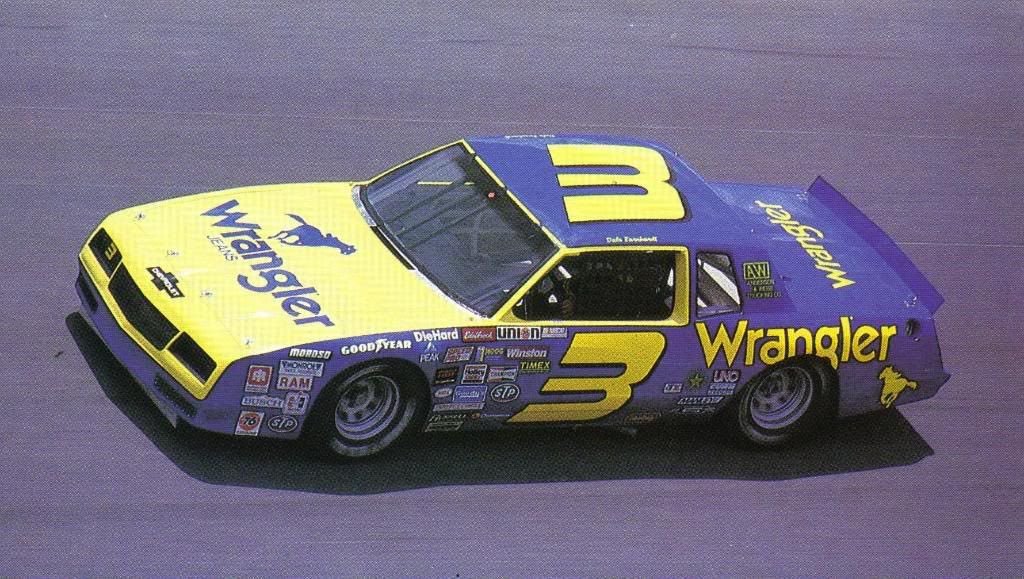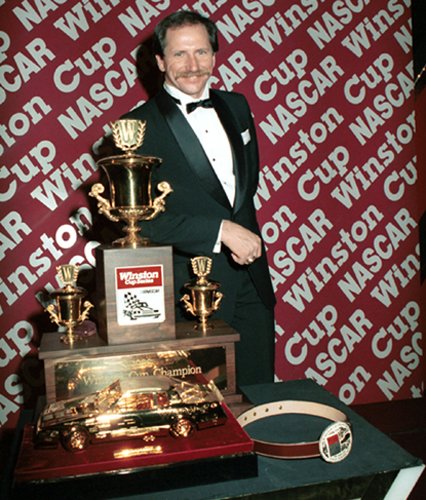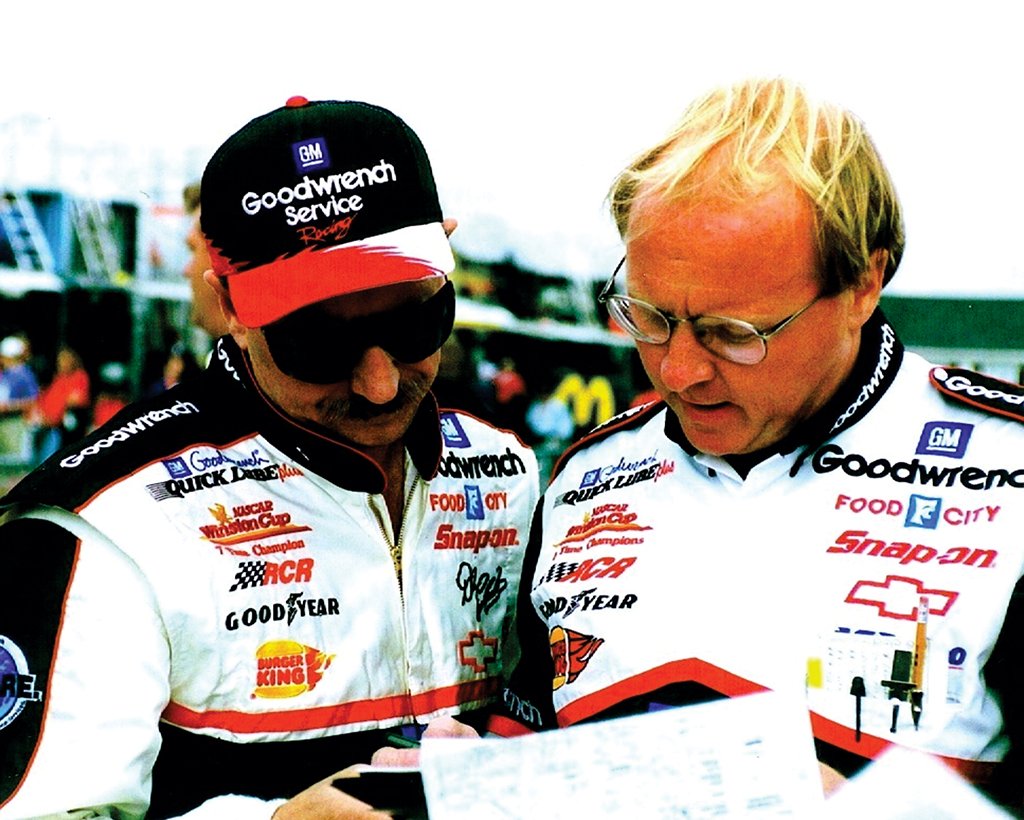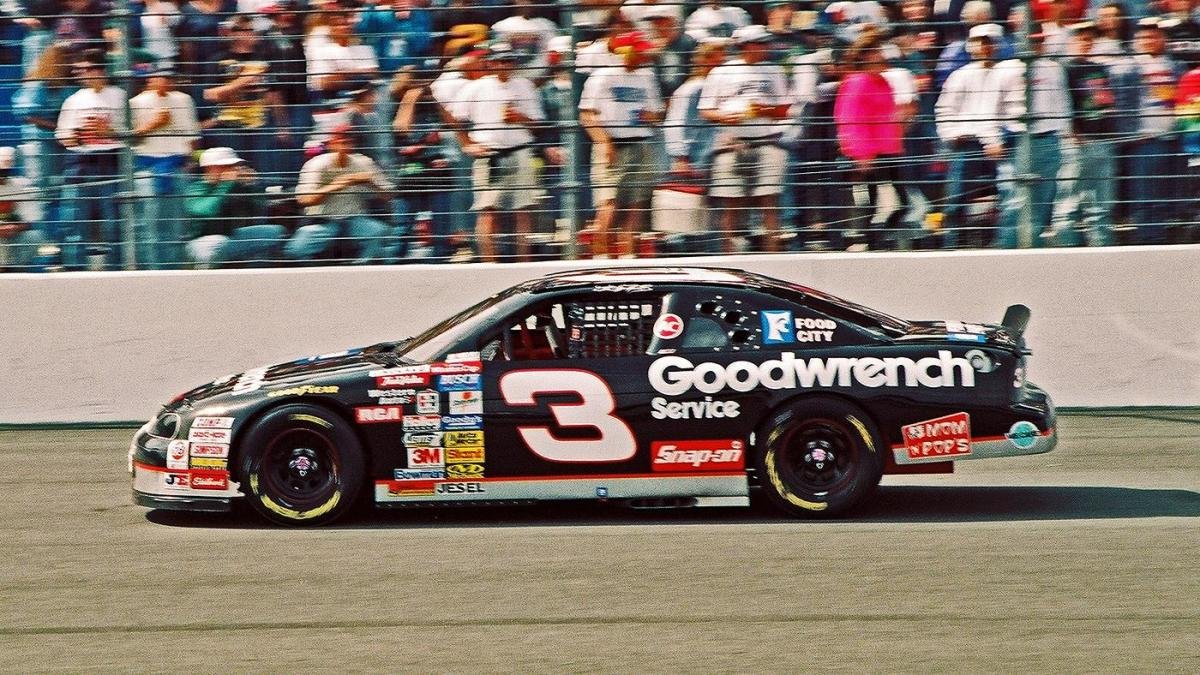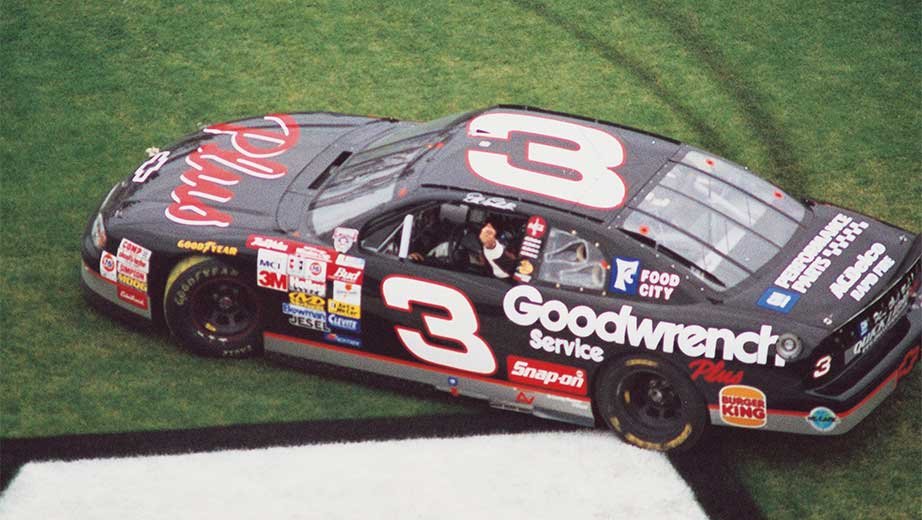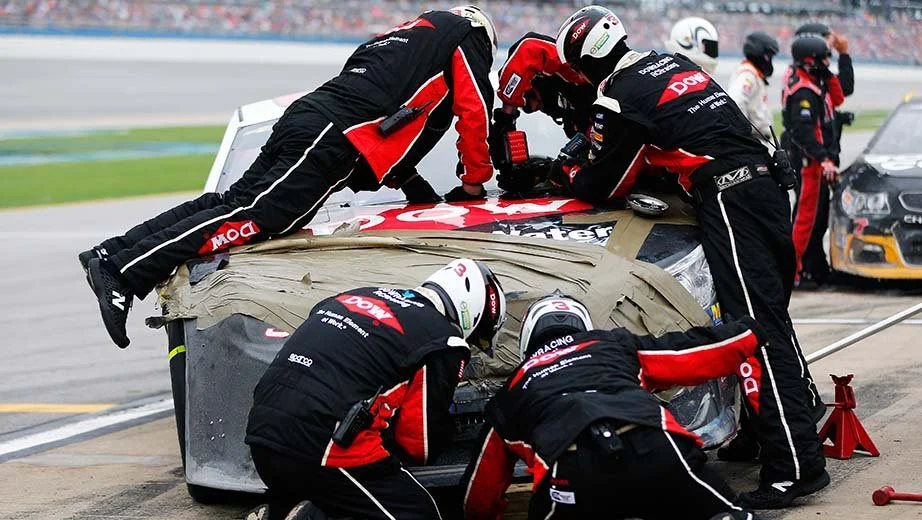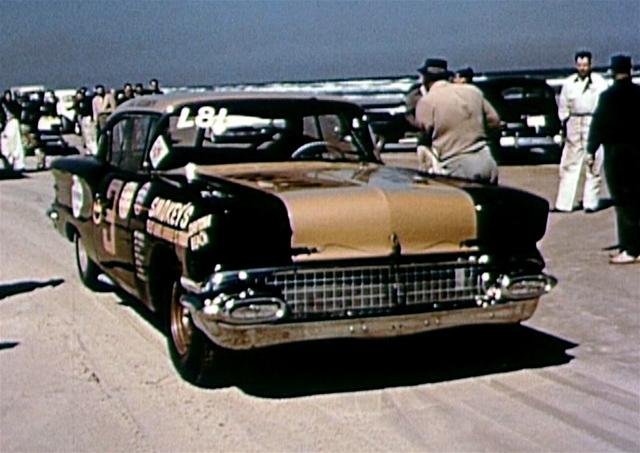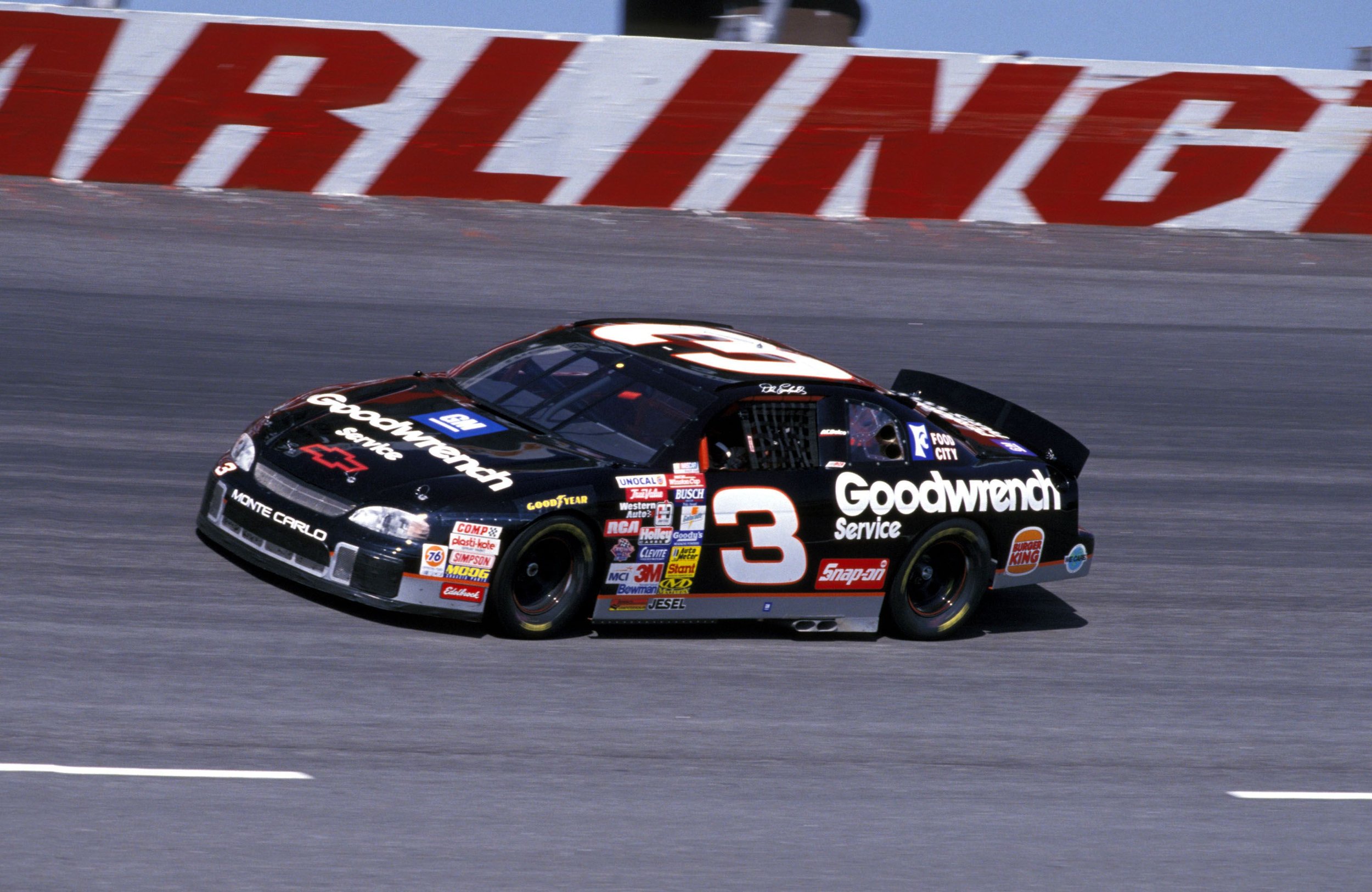
In NASCAR Cup Series competition the #3 car has started 1,462 races with 79 drivers and has 100 wins, 73 poles, 383 top 5s, 662 top 10s, and 307 DNFs.
Richard Childress had been driving part time for 7 years when, in 1976, he decided to begin driving full time in #3. Childress earned eleven top-10 finishes and finished eleventh in points that year. Over the next few years, he posted many top-10s and twice was among the highest top 10 points earners, but he never was in serious contention to win. In 1981, he decided to end his career before the season ended, and handed his #3 ride to the defending Winston Cup champion, Dale Earnhardt, who brought his Wrangler sponsorship with him. Childress started the #3 a total of 172 times.
Dale Earnhardt has the most starts in #3 with 529 from 1981-2001 including 67 of his 76 career wins and 6 of his 7 Championships.
Midway through the 1981 season, Earnhardt’s car owner Rod Osterlund sold his #2 team to J. D. Stacy prompting Earnhardt to leave for Richard Childress Racing. Earnhardt finished 7th in points with no wins. Knowing his equipment was inferior to his driver’s talent; Childress encouraged Earnhardt to race for another team while Childress developed his own shop, insisted that Earnhardt return one day. Earnhardt joined car owner Bud Moore for the 1982 and 1983 seasons driving the #15 Wrangler Ford Thunderbird, but returned to RCR in 1984 to reclaim his #3 car. The second time around was much more successful, creating one of the best owner & driver combinations in the history of the sport.
The 1984 Talladega 500 was Earnhardt’s first win with RCR, the first of 6 wins between the 1984-1985 seasons. The 1986 season saw Earnhardt win his second career Winston Cup Championship and the first owner’s championship for RCR. He won five races (almost six ) and had ten Top 5 and sixteen Top 10 finishes. Earnhardt successfully defended his championship the following year, visiting victory lane eleven times and winning the championship by 489 points over Bill Elliott. In the process, Earnhardt set a NASCAR modern era record of four consecutive wins and won five of the first seven races. In the 1987 season, Earnhardt won The Winston (All Star Race). During this race, Earnhardt was briefly forced into the infield grass, but kept control of his car and returned to the track without giving up his lead. The maneuver is now referred to as the “Pass in the Grass,” even though Earnhardt did not pass anyone while he was off the track.
The 1988 season saw Earnhardt racing with a new sponsor, GM Goodwrench , which replaced Wrangler Jeans. During this season Earnhardt garnered a second nickname, “The Man in Black” , owing to the black paint scheme in which the No. 3 car was painted. He was also called “Darth Vader” more than once because of the black uniform and car, adding to his notoriety as a driver who would wreck any car he could not pass. He won three times in 1988, finishing third in the points standings behind Bill Elliott and Rusty Wallace.
The following year, Earnhardt won five times, but a late spin out at North Wilkesboro arguably cost him the 1989 championship, as Rusty Wallace edged out Earnhardt for the championship.
The 1990 season started for Earnhardt with victories in the Busch Clash and his heat of the Gatorade Twin 125s. Near the end of the Daytona 500, he had a four-second lead when the final caution flag came out with a handful of laps to go. When the green flag waved, Earnhardt was leading Derrike Cope. On the final lap, Earnhardt ran over a piece of metal in the final turn, cutting a tire. Cope, in an upset, won the race while Earnhardt finished fifth. The No. 3 Goodwrench Chevy team took the flat tire that cost them the win and hung it on the shop wall as a reminder of how close they’d come to winning the Daytona 500. Earnhardt went on to win nine races that season and won his fourth Winston Cup title, beating Mark Martin by 26 points. Earnhardt also became the first repeat winner of The Winston.
The 1991 season saw Earnhardt win his fifth Winston Cup Championship . He scored just four wins, but won the championship by 195 points over Ricky Rudd. Earnhardt’s only win of the 1992 season came at Charlotte, in the Coca-Cola 600, ending a 13-race win streak by Ford teams. Earnhardt finished a career-low 12th in the points. At the end of the year, longtime crew chief Kirk Shelmerdine left to become a driver. Andy Petree took over as crew chief.
In 1993 Earnhardt once again came close to a win at the Daytona 500, and dominated Speedweeks before finishing second to Dale Jarrett on a last-lap pass. Earnhardt scored six wins en route to his sixth Winston Cup title, including wins in the Coca-Cola 600 and The Winston at Charlotte, and the Pepsi 400 at Daytona. Earnhardt beat Rusty Wallace for the Championship by 80 points.
In 1994, Earnhardt achieved a feat that he himself had believed to be impossible – he scored his seventh Winston Cup championship, tying Richard Petty. Earnhardt was very consistent, scoring four wins, and after Ernie Irvan was sidelined due to a near-deadly crash at Michigan, won title by over 400 points over Mark Martin. He won five races in 1995, including his first road course victory at Sears Point . He also won the Brickyard 400 at Indianapolis Motor Speedway, a win he called the biggest of his career.
For 1996, Larry McReynolds was named Earnhardt’s crew chief. In late July, in the DieHard 500 at Talladega , he was in the points lead and looking for his eighth title despite the departure of crew chief Andy Petree. Late in the race, Ernie Irvan lost control of his Ford Thunderbird, made contact with the Chevy of Sterling Marlin, and igniting a frightening crash that saw Earnhardt’s car hit the tri-oval wall nearly head-on at almost 200 miles per hour. After hitting the wall, Earnhardt’s car flipped and slid across the track, in front of race-traffic. His car was hit in the roof and windshield. This accident, as well as a similar accident that led to the death of Russell Phillips at Charlotte, led NASCAR to mandate the “Earnhardt Bar”, a metal brace located in the center of the windshield that reinforces the roof in case of a similar crash.
After a disappointing and winless 1997 season, 1998 saw Earnhardt finally win the Daytona 500 after being shut out in his previous 19 attempts. Afterwards, there was a large show of respect for Earnhardt, in which every crew member of every team lined pit road to shake his hand as he made his way to victory lane. Earnhardt then drove his car into the infield grass , starting a trend of post-race celebrations. He spun the car twice, throwing grass and leaving tire tracks in the shape of a #3 in the grass.
Earnhardt struggled in 1999, but after a neck surgery to repair damage from his 1996 accident at Talladega, Earnhardt showed a resurgence in 2000 Winning at Atlanta and Talladega . Earnhardt was in contention for his record setting 8th championship, but would ultimately finished 2nd to Bobby Labonte.
Going into 2001 Earnhardt and Childress agreed that they were prepared to compete for another championship. Tragically, on the final lap of the 2001 Daytona 500 Earnhardt was killed in crash while watching the cars he owned, Michael Waltrip and Dale Earnhardt Jr., finish 1-2 in the Great American Race. His death shocked the NASCAR community and the sports world. The next week, Kevin Harvick raced with Earnhardt’s team, now bearing #29. Earnhardt is remembered not only as a legendary competitor and champion of the sport, but as an innovator. Earnhardt revolutionized his self-branding and merchandise sales to grow his popularity and fan base, founded a state of the art race team with Dale Earnhardt Inc, and was constantly communicating with the NASCAR sanctioning body on the behalf of the drivers for rule changes and new ideas. In the aftermath of his death, NASCAR underwent a safety revolution resulting in much safer racing today. Earnhardt was 49.
In the 2 years between Earnhardt’s stints at RCR, Ricky Rudd drove the #3 for Childress. From 1982-1983 Rudd made 60 starts in the Piedmont Airlines #3 winning 2 races. Ironically, when Earnhardt returned to RCR, Rudd replaced Earnhardt in the Bud Moore #15. For one year both cars were sponsored by Wrangler Jeans.
Buddy Baker started 60 races in Ray Fox’s #3 from 1966-1969 with 2 wins. In 1964, Buddy’s father Buck Baker started the #3 car 22 times winning 2 races including the 1964 Southern 500.
From 1961-1964 Junior Johnson started 49 races in #3, winning 9 of them.
Dick Rathmann started 45 races in #3 from 1954-1955 and he won 3 of them. Rathmann was an early explorer of all forms of motorsports racing in NASCAR, USAC, The Indy 500, and Formula 1.
In 2014 Austin Dillon began driving the #3 car for his grandfather Richard Childress. Though Dillon had a quiet rookie year with no wins, he managed to run all 36 races without a single DNF, a feat unmatched by anyone else in the series. Dillon’s streak would come to an end in 2015 with 3 DNFs, one for electrical issues, one for an expired engine, and one for an accident. Dillon’s biggest highlight of the year was for a wreck that did not cause a DNF, as it happened after the finish line at Daytona in July. In 2017, Dillon found victory lane after a fuel milage victory at the Coke 600. Dillon would make the playoffs, but was eliminated in the 2nd round, finishing 11th in the final standings.
In 2016, Dillon quietly put together a steady and consistent year, earning 4 top 5s, 13 top 10s, and 2 poles. Dillon’s most notable top-5 came at the Spring Talladega race where he managed to place 3rd with a beat up, taped together car. Dillon’s consistency would earn him a spot in The Chase, despite not having earned a win. He would advance to the Round of 12 before being eliminated.
In 2017, Dillon would score his first career Cup Series win at the Coca Cola 600 in Charlotte.
Dillon started 2018 with a win in NASCAR’s most prestigious race: The Daytona 500. On the final lap Dillon turned leader Aric Almirola to take the win, 20 years after Dale Earnhardt won the race in car #3. It was also 17 years to the day of Earnhardt’s death. Despite the win and a guaranteed spot in the Playoffs, Dillon struggled to stay consistent throughout the season with two top-fives and five top-10 finishes. He was eliminated in the Round of 16 after hitting the outside wall twice at the Charlotte Roval race and finished the season 13th in points.
Dillon and RCR showed qualifying speed early in the 2019 season, winning pole awards at Auto Club and Talladega. At Michigan, Dillon managed to get his first career stage win in the Cup Series by winning the second stage. Dillon performed well at the July Daytona race, leading the most laps (46) and winning stage 2. However, with 40 laps to go, as severe weather was approaching the track, Clint Bowyer made contact with Dillon causing a multi-car accident. Dillon finished with a DNF in 33rd place. Dillon failed to make the playoffs for the first time since 2015 as he fell outside the top twenty in points. He finished 21st in the final points standings, tying his lowest in a full-time season with zero-top fives for the first time in his career.
After a slow start to 2020, On July 19, Dillon broke an 88-race winless streak by claiming his 3rd career victory at the 2020 O’Reilly Auto Parts 500 at Texas Motor Speedway. RCR teammate Tyler Reddick finished second to secure an RCR 1–2 finish for the first time since the 2011. It was Dillon’s first victory where he led more than the final two laps, as he took the lead with 23 to go and held off Reddick over several restarts. On August 15, it was announced that Dillon tested positive for the COVID-19 virus, forcing him to miss the Go Bowling 235 at the Daytona Road Course; Kaz Grala served as his replacement for the race. Dillon returned to the No. 3 for the following week at Dover. The win at Texas secured the #3 team’s spot in the NASCAR Playoffs, but they would be eliminated following the Round of 12 at the Charlotte Roval. Dillon finished 11th in the points standings.
Dillon began the 2021 season with a win in his Duel for the Daytona 500 by passing Bubba Wallace on the final lap, which enabled him to start fourth for the 500. Dillon would go on to lead 7 laps in the 500 and finish in 3rd-place after avoiding a last-lap crash, assuming the points lead for the first time in his career. At Michigan in August, Dillon was having a much needed good run- he was sitting just outside the Top 16 in points and was in desperate need of a win to make the 2021 Playoffs. His pace at Michigan might have landed him in victory lane, had a collision with Brad Keselowski not sent him careening into the wall, almost flipping. Dillon would miss the playoffs and finish 17th in the standings.
In 2022, Dillon snuck into the Playoffs by winning the regular season finale at Daytona in August, his 4th career win. A poor showing in the Round of 16 would cause Dillon to be eliminated from Championship contention just 3 races later. He finished 11th in the standings. Dillon has started 323 races in #3, and he will return in 2023.
Like Rathmann, Paul Goldsmith also raced everything he could get his hands on like motorcycles, the Indy 500, and NASCAR . He made 29 Cup starts from 1956-1958 & 1969 earning a total of 5 wins.
Other notable drivers in #3:
Charlie Glotzbach , 14 starts, 1 win
David Pearson , 13 starts, 3 win
Cotton Owens, 10 starts
Cale Yarborough, 4 starts
Fireball Roberts, 4 starts, 1 win
Danny Letner, 2 starts, 1 win
Earl Barlmer, 2 starts, 1 win



